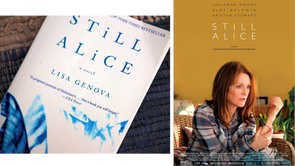|
3/1/2015 0 Comments Book review: Still Alice
By Christine Arasaratnam
As I have not watched the movie yet, my perspective on the story of Still Alice remains as fresh as when I first read the novel. However, with its rave reviews and the attention that Julianne Moore (winner of the Golden Globes, SAG and Academy awards for best actress) has been receiving, it was definitely time to revisit the book.
I first picked up the novel as an undergraduate neuroscience student, and it was a wonderful insight into a world rich with the experiences of a woman in academia. The book relates the story of Dr. Alice Howland, a linguistics professor at Harvard, wife to a cancer researcher, Dr. John Howland, and mother of three grown children. The catalyst of the story is the discovery that Alice has early-onset Alzheimer’s disease, an event that reverberates through every facet of her life, from her role as a lecturer, researcher, graduate student supervisor, wife and mother.
From the view of a woman in science, it provides a stretch of the imagination on how any woman, particularly one in academia, would cope with such a diagnosis. With a wealth of knowledge at one’s finger tips, and friends and colleagues at the forefront of discovery, it is entirely possible to imagine oneself buried in an almost obsessive need to assess, analyse and understand, thus being able to plot ourselves along an imaginary line from ‘normal’ to our own definition of ‘diseased’. The character of Alice faces the challenge and sets out on a journey which changes her in every way. Although some of us are studying this very disease, along with other neurodegenerative diseases, we are able to switch off the laptops, lay aside the stack of journal articles, and return home to friends and family. In the case of Alice, we are able to envision what it would be like should such a disease or diagnosis follow us home, affecting everything we did, making us forget recipes that we had previously remembered every year without fail, and making us forget how to put on our own clothes. Particularly heart-breaking is the gradual loss of Alice’s ability to distinguish that her family members are indeed her own, and the writer effectively conveys Alice’s confusion tempered with frustration. It has been said that we do not know a person unless we have walked a mile in their shoes, and this book provides us with the opportunity to understand anyone who has had the diagnosis of Alzheimer’s disease placed upon them. For sometimes as scientists we may benefit in stepping back from the label to see that the person in front of us is still Stephen, or still Mum, or in this case still Alice. Perhaps this is something that our research should demand from us, because seeing the issue as a whole provides us with a perspective and the energy to do the work that has been so gifted to us.
About the author
Christine is a graduate neurosciences student exploring the distribution of different and various neurons in the human brain. She has also investigated cellular changes in Huntington’s disease, and hopes to extend this research to Parkinson’s disease. She loves to try her hand at all things cooking and baking (which has led to a signature chocolate brownie recipe). Her ability to play the piano and violin would be passable, and she knows enough sport to give a decent summary of the English Premier League (soccer for all the Americans!) Comments? Leave them below!
0 Comments
Your comment will be posted after it is approved.
Leave a Reply. |
LIFESTYLE BLOGRead our lifestyle advice, written exclusively for pre-professional women in science and engineering. From advice about fashion, work and family balance, self, wellness, and money, we've got you covered! |
The Scientista Foundation, Inc. All Rights Reserved © 2011-2021 | Based in NY | [email protected]
The Network for Pre-Professional Women in Science and Engineering
The Scientista Foundation is a registered 501(c)(3) -- Donate!
The Network for Pre-Professional Women in Science and Engineering
The Scientista Foundation is a registered 501(c)(3) -- Donate!

